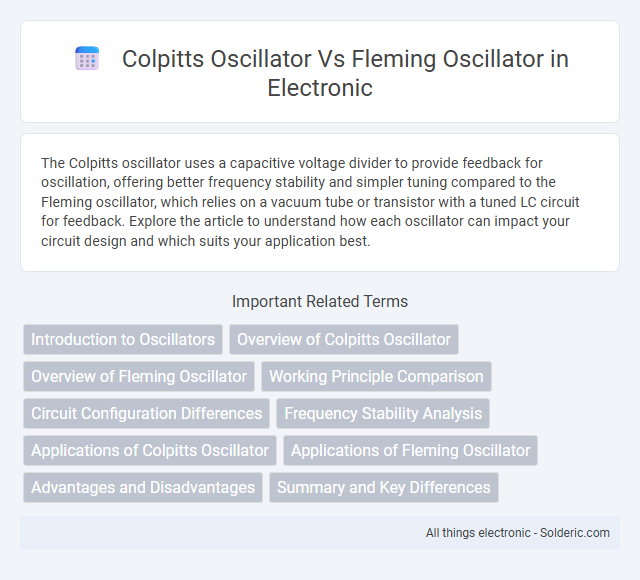The Colpitts oscillator uses a capacitive voltage divider to provide feedback for oscillation, offering better frequency stability and simpler tuning compared to the Fleming oscillator, which relies on a vacuum tube or transistor with a tuned LC circuit for feedback. Explore the article to understand how each oscillator can impact your circuit design and which suits your application best.
Comparison Table
| Feature | Colpitts Oscillator | Fleming Oscillator |
|---|---|---|
| Oscillation Type | LC Oscillator | LC Oscillator |
| Feedback Network | Capacitive voltage divider (two capacitors) | Transformer feedback (mutual inductance) |
| Active Device | Bipolar Junction Transistor (BJT) or FET | Vacuum Tube (Triode) |
| Tuning | Adjust capacitor values in voltage divider | Adjust primary or secondary coil inductance |
| Frequency Stability | High, due to fixed capacitor ratio | Moderate, depends on transformer properties |
| Output Waveform | Sine wave | Sine wave |
| Typical Application | RF signal generation, wireless transmitters | Early radio transmitters, vacuum tube circuits |
| Complexity | Simple capacitor divider feedback | More complex transformer feedback design |
Introduction to Oscillators
Colpitts oscillator uses a capacitive voltage divider to provide feedback, making it ideal for high-frequency signal generation in RF circuits. Fleming oscillator is an early vacuum tube oscillator that relies on negative resistance for sustaining oscillations, primarily used in low-frequency applications. Both oscillators are fundamental in understanding electronic signal generation but differ significantly in design and frequency handling.
Overview of Colpitts Oscillator
The Colpitts Oscillator features a capacitive voltage divider network that determines its oscillation frequency, making it highly stable and suitable for high-frequency applications. It utilizes a single transistor with a series LC circuit composed of two capacitors and one inductor for frequency selection. Compared to the Fleming Oscillator, which uses a separate feedback mechanism and a vacuum tube, the Colpitts Oscillator offers better signal purity and simpler implementation in modern electronic circuits.
Overview of Fleming Oscillator
The Fleming oscillator is a type of vacuum tube oscillator that uses a single triode or pentode to generate continuous sinusoidal waveforms, relying on positive feedback through a tuned LC circuit. It is known for its stability and simplicity in producing high-frequency signals, often employed in radio frequency applications. Compared to the Colpitts oscillator, which uses capacitive voltage division for feedback, the Fleming oscillator typically utilizes inductive feedback, influencing its frequency stability and application range.
Working Principle Comparison
The Colpitts oscillator operates on the principle of a resonant LC circuit with a capacitive voltage divider, where the feedback is taken from the split capacitors to sustain oscillations. In contrast, the Fleming oscillator uses a vacuum tube or diode and relies on grid biasing with an inductive coil to generate sustained oscillations. Understanding these working principles helps you choose the appropriate oscillator type based on the frequency stability and circuit complexity required.
Circuit Configuration Differences
The Colpitts oscillator utilizes a capacitive voltage divider as the feedback network, typically consisting of two capacitors connected in series with a transistor or FET, forming an LC tank circuit for frequency determination. In contrast, the Fleming oscillator employs an inductive feedback arrangement using a single capacitor and a tapped inductor or transformer to provide the necessary phase shift and feedback for oscillation. The distinct feedback components in each circuit directly influence their stability, frequency range, and implementation complexity.
Frequency Stability Analysis
The Colpitts oscillator offers superior frequency stability due to its reliance on a capacitive voltage divider, which provides better control over the oscillation frequency and reduces phase noise compared to the Fleming oscillator's simpler LC tank circuit. Temperature variations and component tolerances impact the Fleming oscillator more significantly, leading to greater frequency drift over time. When designing your circuit for precise frequency stability, the Colpitts oscillator is often preferred because it maintains consistent output frequency under varying environmental conditions.
Applications of Colpitts Oscillator
Colpitts oscillators are widely used in radio frequency (RF) signal generation, frequency synthesizers, and local oscillators due to their stable frequency output and ease of frequency tuning. Their application extends to communication systems, including transmitters and receivers, where they provide reliable sinusoidal waveforms for modulating signals. The design flexibility and high-frequency performance make Colpitts oscillators a preferred choice over Fleming oscillators in RF and microwave circuit applications.
Applications of Fleming Oscillator
The Fleming oscillator is widely used in radio frequency generation and early AM radio transmitters due to its ability to produce stable sine waves at high frequencies. It finds applications in signal generation for communication systems and as a fundamental component in vacuum tube-based circuits. Your design projects can benefit from its simplicity and efficient feedback mechanism when working with vacuum tube or valve technology.
Advantages and Disadvantages
The Colpitts oscillator offers better frequency stability and simpler tuning due to its capacitive voltage divider, making it ideal for high-frequency applications. The Fleming oscillator is more robust and easier to design for lower frequencies but tends to have lower frequency stability and higher distortion. Your choice depends on whether you prioritize frequency precision or design simplicity in your circuit.
Summary and Key Differences
The Colpitts oscillator uses a capacitive voltage divider for feedback, providing stable frequency generation suitable for high-frequency applications, while the Fleming oscillator, a type of vacuum tube oscillator, employs a separate feedback coil and is mainly used in low-frequency radio circuits. Key differences include the Colpitts oscillator's reliance on capacitors in the feedback network versus the Fleming oscillator's inductive feedback method, affecting their frequency stability and operational range. You can choose between these based on your specific needs for frequency stability, circuit complexity, and application frequency band.
colpitts oscillator vs fleming oscillator Infographic

 solderic.com
solderic.com